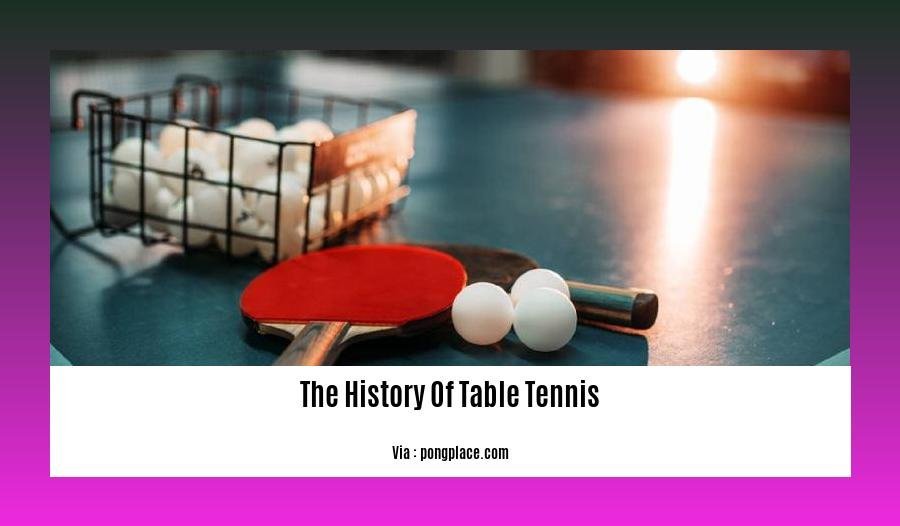Unravel the captivating history of table tennis, a sport that has enthralled enthusiasts worldwide with its intricate blend of skill, strategy, and global impact. From its humble origins in the late 19th century to its ascent as a globally recognized sporting phenomenon, this article takes you on a journey through the annals of table tennis, revealing the fascinating stories, legendary players, and pivotal moments that have shaped its remarkable evolution. Get ready to delve into the rich tapestry of table tennis, a sport that has captured the hearts and imaginations of millions across the globe.
Key Takeaways:
- Table tennis, also known as ping-pong, originated in Victorian England as a parlor game and was brought back to England from India by British military officers.
- Table tennis is played by hitting a small ball across a table using a paddle.
- It became an Olympic sport in 1988 for both men and women.
- East Asian countries have been dominating the sport since the mid-1950s.
History of Table Tennis: A Legacy of Skill and Global impact

Welcome to a journey through time, where we explore the evolution of a sport that has captured the hearts and minds of enthusiasts worldwide – the history of table tennis. From its humble beginnings to its rise as a globally recognized sport, join us as we uncover the captivating stories that have shaped the identity of table tennis.
The Early Paddles
In the Victorian era of England, table tennis emerged as a captivating after-dinner parlor game reserved for the upper echelons of society. Its roots can be traced back to the late 19th century, where it was initially known as “whiff-whaff” or “gossima.” These early iterations involved wooden paddles and a ball made of cork or rubber, setting the stage for the sport’s future development.
A Game of Military Officers
The game’s popularity spread beyond the confines of English parlors when British military officers stationed in India were introduced to it in the 1870s. Captivated by its strategic and competitive nature, they embraced the game and introduced it to their fellow officers back in England. This marked a pivotal moment in the history of table tennis, as it laid the foundation for the sport’s transformation into a global phenomenon.
The Birth of Modern Table Tennis
Upon its return to England, table tennis underwent a series of modifications and refinements, evolving into the sport we recognize today. In the early 20th century, standardized rules and regulations were established, and the game’s popularity soared, spreading across Europe and beyond.
A Global Phenomenon
The early 20th century witnessed the rise of table tennis as a global sport. International tournaments and competitions were organized, drawing participants from around the world. The sport’s growing popularity culminated in its recognition as an official Olympic sport in 1988, a testament to its widespread appeal and competitive spirit.
The Dominance of East Asia
Since the mid-1950s, East Asian countries, particularly China, have dominated the world of table tennis. Chinese players have consistently showcased exceptional skill, strategy, and athleticism, securing numerous titles and accolades. This dominance has significantly shaped the history of table tennis, making it a sport where precision, finesse, and mental fortitude are held in the highest regard.
A Sport for All
Table tennis has transcended cultural and geographical boundaries, becoming a beloved sport enjoyed by people of all ages and backgrounds. Its accessibility, affordability, and engaging nature have contributed to its widespread popularity. Whether played as a casual pastime or pursued as a competitive sport, table tennis continues to captivate hearts and minds worldwide.
As we reflect on the history of table tennis, we recognize its remarkable journey from a parlor game to a global sporting phenomenon. Its evolution has been marked by innovation, skill, strategy, and global camaraderie, solidifying its place as a sport that continues to inspire and entertain.
-
Check out the history of classical music in this fascinating article: the history of classical music
-
Curious about the history of cookies? Delve into this captivating piece: the history of cookies
-
Get ready for a mind-bending journey as we explore the history of science fiction in this insightful article: the history of science fiction
Rise of International Competitions
International competitions have played a pivotal role in elevating table tennis to its current status as a globally recognized and celebrated sport. These events have provided a platform for the world’s best players to showcase their skills, fostering a sense of camaraderie and healthy rivalry among nations. The rise of international competitions has undoubtedly contributed to the sport’s growth and popularity on a global scale.
The Early Days of International Table Tennis
Initially, table tennis competitions were primarily held at the national level. As the sport gained popularity and recognition, the need for international tournaments arose. In 1926, the International Table Tennis Federation (ITTF) was founded to oversee the organization and standardization of table tennis competitions worldwide. The ITTF’s formation marked a significant milestone in the sport’s history, paving the way for the development of structured international tournaments.
The World Championships: A Prestigious Stage
One of the most prestigious international table tennis events is the World Championships, which were first held in 1926. The World Championships are held biennially and bring together the world’s top players to compete for individual and team titles. The event has a rich history and has witnessed some of the sport’s most memorable matches and iconic moments. Many renowned players, such as Viktor Barna, Johnny Leach, and Deng Yaping, have etched their names in table tennis history through their remarkable performances at the World Championships.
The Olympic Games: Table Tennis Takes the Global Stage
Table tennis made its Olympic debut at the 1988 Seoul Games as a demonstration sport. It was officially recognized as an Olympic medal event at the 1992 Barcelona Games, marking a significant milestone in the sport’s global recognition. The inclusion of table tennis in the Olympics has provided a platform for the sport to reach a wider audience and has contributed to its growing popularity worldwide. Many nations view Olympic medals in table tennis as a symbol of national pride and sporting excellence.
The ITTF World Tour: A Global Circuit of Excellence
The ITTF World Tour, established in 1996, is a series of international table tennis tournaments held throughout the year. The World Tour provides a competitive platform for players to earn ranking points and compete for prize money. The tour consists of several levels, including the World Tour Grand Finals, which feature the top-ranked players. The World Tour has played a significant role in promoting table tennis globally, attracting players from all corners of the world and showcasing the sport’s diverse talents.
Key Takeaways:
- International competitions have been instrumental in elevating table tennis to a global sport.
- The ITTF’s formation in 1926 marked a pivotal moment in the organization and standardization of international table tennis competitions.
- The World Championships, held biennially, is one of the most prestigious international table tennis events and has a rich history of memorable matches.
- Table tennis’ inclusion in the Olympic Games in 1992 significantly boosted its global recognition and popularity.
- The ITTF World Tour, established in 1996, is a series of international tournaments that provides a competitive platform for players to earn ranking points and prize money.
Citations:
The Complete History of Table Tennis
History of Table Tennis
The Advent of Professional Table Tennis

The evolution of table tennis from a mere pastime to a globally recognized professional sport is a captivating tale of skill, strategy, and perseverance.
In the early 20th century, table tennis captivated the hearts of enthusiasts worldwide. However, it wasn’t until the 1950s that the sport took a monumental leap towards professionalism, largely influenced by the rise of East Asian nations as table tennis powerhouses.
These nations, particularly China, showcased exceptional skill and strategic prowess, inspiring awe and admiration among players and spectators alike. Gradually, the sport’s popularity soared, attracting sponsorships, lucrative prize money, and the attention of professional athletes seeking to make their mark on the global stage.
The establishment of professional table tennis leagues, such as the Chinese Super League and the Japan League, further solidified the sport’s status as a viable career path. These leagues provided a platform for talented players to showcase their skills, compete at the highest level, and earn substantial financial rewards.
The advent of professional table tennis brought about a surge of innovations in equipment and techniques. Players experimented with new rubber compounds, blade designs, and training methods to gain an edge over their competitors. These advancements not only elevated the level of play but also transformed the sport into a dynamic and visually captivating spectacle.
The transition to professionalism also led to the establishment of governing bodies, such as the International Table Tennis Federation (ITTF), which standardized rules, regulations, and rankings. This structure ensured fairness, consistency, and transparency in competitions, further enhancing the sport’s credibility and appeal.
Key Takeaways:
-
The rise of East Asian nations as table tennis powerhouses in the 1950s fueled the sport’s transition to professionalism.
-
Professional table tennis leagues, such as the Chinese Super League and the Japan League, provided a platform for athletes to showcase their skills and earn substantial financial rewards.
-
The advent of professionalism spurred innovations in equipment and techniques, transforming the sport into a dynamic and visually captivating spectacle.
-
Governing bodies like the International Table Tennis Federation (ITTF) standardized rules and regulations, ensuring fairness, consistency, and transparency in competitions.
Sources:
- The History and Evolution of Table Tennis
- The Professionalization of Table Tennis
Table Tennis in the Modern Era
Adapting to the digital age and utilizing cutting-edge technologies have played a crucial role in table tennis’s evolution over the years. By embracing social media, live streaming, and digital platforms, the sport has become more accessible and engaging to a global audience.
The rise of “table tennis robots,” which precisely simulate human opponents, has pushed the boundaries of training and practice. These robotic devices offer a consistent and challenging training regimen that helps players hone their skills and improve their game.
Speed Glue and the Demise of “Shakehand” Players:
A Paradigm Shift:
In the sport’s early days, players primarily used a “shakehand” grip, holding the racket with their dominant hand and striking the ball with their palm facing forward. However, with the advent of speed glue in the 1980s, which increased the spin and speed of the ball, a new technique emerged.
Contemporary players adopted the “penhold” grip, holding the racket with their dominant hand and placing their thumb and forefinger on the same side of the blade. This grip allowed for greater finesse and control, enabling players to generate more spin and accuracy with their shots.
Rise of the Chinese Dynasty & Dominance in Table Tennis:
A Dynasty Unparalleled:
China’s table tennis dominance began in the 1950s and has continued unabated to this day. This can be attributed to a combination of factors:
-
Cultural Emphasis on Table Tennis: In China, table tennis is considered a national sport and is widely played at the grassroots level. This deep cultural connection has produced a vast pool of talented players.
-
Comprehensive Training System: China’s national table tennis training system is rigorous and comprehensive. Players are selected at a young age and undergo intensive training programs that focus on technique, tactics, and physical conditioning.
-
Government Support: The Chinese government provides significant support to table tennis, funding training facilities, sponsoring tournaments, and promoting the sport at all levels.
Bigger Tables, Lighter Paddles, and a Growing Fan Base:
Modern Adjustments:
To enhance the game’s appeal, the International Table Tennis Federation (ITTF) has implemented several changes in recent years:
-
Larger Table Size: In 2000, the size of the table was increased from 5 feet 6 inches to 5 feet 9 inches. This change aimed to slow down the game and make it more tactical and less reliant on power.
-
Lighter Paddles: The ITTF also approved the use of lighter paddles, enabling players to generate more spin and control.
-
Fan Engagement: The ITTF has made concerted efforts to increase fan engagement by promoting table tennis on social media, hosting live streaming events, and improving the presentation of the sport at major tournaments.
Innovations in Equipment & Playing Styles:
Technological Advancements:
In recent years, innovations in equipment and playing styles have further transformed the sport of table tennis:
-
Rubber Technology: Advances in rubber technology have produced high-performance rubbers that allow players to generate more spin and speed.
-
Blade Design: New blade designs, such as carbon fiber blades, have increased the power and control of table tennis paddles.
-
Playing Styles: The emergence of new playing styles, such as the “backhand loop” and the “forehand topspin,” have added depth and variety to the game.
Key Takeaways:
-
Modernization: Table tennis has embraced technology, utilizing social media, live streaming, and digital platforms to reach a global audience.
-
Training Evolution: The use of table tennis robots and advanced training methods has revolutionized the way players practice and improve their skills.
-
Chinese Dominance: China’s dominance in table tennis is attributed to a combination of cultural factors, a comprehensive training system, and government support.
-
Equipment Innovations: Larger tables, lighter paddles, and advanced rubber technology have influenced the game’s dynamics.
-
Playing Styles: New playing styles, such as the “backhand loop” and the “forehand topspin,” have enriched the sport.
Citations:
[1] History of Table Tennis: From Origin to Olympic Debut
[URL:
[2] The Evolution of Table Tennis Equipment
[URL:
FAQ
Q1: What is the origin of table tennis?
A1: Table tennis traces its roots back to the Victorian era in England, where it was initially played as a parlor game among the upper class. Later, British military officers stationed in India refined the game and brought it back to England, leading to its widespread popularity in the early 20th century.
Q2: How did table tennis gain global recognition?
A2: The establishment of the English Table Tennis Association (ETTA) in 1901 and the German Table Tennis Association (DTTB) in 1925 laid the foundation for organized competitions. The formation of the International Table Tennis Federation (ITTF) in 1926 further solidified the sport’s global presence, with over 200 national member associations and 33 million players worldwide.
Q3: Why is table tennis also known as ping-pong?
A3: The term ‘ping-pong’ originated as a trademarked name for the game’s equipment. However, the name ‘table tennis’ was officially adopted in the 1930s to reflect the sport’s growing global appeal and to avoid potential legal issues surrounding the trademark.
Q4: When did table tennis become an Olympic sport?
A4: Table tennis gained Olympic recognition in 1988 when it was included as an official medal event at the Summer Olympics in Seoul, South Korea. This marked a significant milestone in the sport’s history and contributed to its increased popularity and global reach.
Q5: Which country has been dominant in table tennis?
A5: China has been the dominant force in table tennis, showcasing exceptional skill, strategy, and consistency. Chinese players have achieved remarkable success in major international tournaments, including the World Championships and the Olympic Games. Their dominance can be attributed to a combination of factors, including a strong emphasis on training, talent development, and a deep-rooted passion for the sport.
- Unraveling Einstein’s Legacy: Who Inherited His Genius? - July 14, 2025
- Unlock Einstein’s Family Tree: Bernhard Caesar & Untold Stories - July 14, 2025
- Unveiling Bernhard Caesar Einstein: His Life & Albert Einstein’s Legacy - July 14, 2025
















